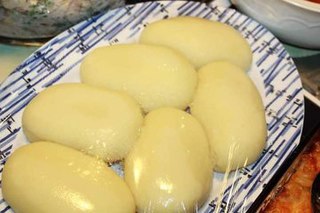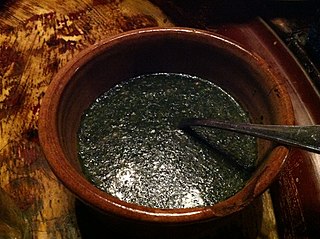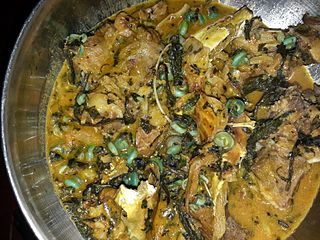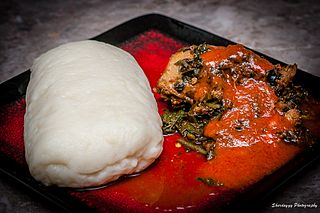
Jute is a long, rough, shiny bast fiber that can be spun into coarse, strong threads. It is produced from flowering plants in the genus Corchorus, of the mallow family Malvaceae. The primary source of the fiber is Corchorus olitorius, but such fiber is considered inferior to that derived from Corchorus capsularis.

Fufu is a pounded meal found in West African cuisine. It is a Twi word that originates from the Akans in Ghana. The word has been expanded to include several variations of the pounded meal found in other African countries including Sierra Leone, Guinea, Liberia, Cote D'Ivoire, Burkina Faso, Benin, Togo, Nigeria, Cameroon, the Democratic Republic of Congo, the Central African Republic, the Republic of Congo, Angola, and Gabon.

Ẹ̀bà (Yoruba) also known as Ebe or Pinon' is a staple swallow from Togo and Benin, also eaten in the West African sub-region and other African countries. The term èbà originates from Yoruba. It is also called utara by the Igbo people of southeast Nigeria. It is a cooked starchy vegetable food made from dried grated cassava (manioc) flour commonly known as garri all across West Africa. It is often eaten with rich soups and stews, with beef, stockfish or mutton. The dish is often described as having a slightly sour, sharp taste.

Corchorus is a genus of about 40–100 species of flowering plants in the family Malvaceae, native to tropical and subtropical regions throughout the world.

Ugali, also known as posho, nsima, and other names, is a type of corn meal made from maize or corn flour in several countries in Africa. It is cooked in boiling water or milk until it reaches a stiff or firm dough-like consistency. In 2017, the dish was added to the UNESCO Representative List of the Intangible Cultural Heritage of Humanity, one of a few foods in the list.

Egusi also known as agusi, ohue, Ikpan, Ikon, agushi or mbíka) is the name for the protein-rich seeds of certain cucurbitaceous plants, which, after being dried and ground, are used as a major ingredient in West African cuisine.

Àmàlà is a staple swallow food popularized by the Yoruba ethnic group of Southwestern Nigeria and other parts of Yorubaland. It is made of yam, cassava flour, or unripe plantain flour. Tubers of yams are peeled, sliced, cleaned, dried and then ground into flour. It is also called èlùbọ́. Yams are white in colour but turn brown when dried which gives àmàlà its colour. It is a popular side dish served with ewédú and gbẹ̀gìrì, but is also served with a variety of other ọbè(soups), such as ẹ̀fọ́, ilá, and ogbono.

Mulukhiyah, also known as molokhia, molohiya, or ewedu, is a dish made from the leaves of Corchorus olitorius, commonly known in English as jute mallow,nalta jute,tossa jute and denje'c'jute. It is used as a vegetable and is mainly eaten in Egypt, the Levant, Sudan, Cyprus, Libya, Tunisia and Algeria. It is called “Saluyot” in the Philippines. Mulukhiyah is rather bitter, and when boiled, the resulting liquid is a thick, highly mucilaginous broth; it is often described as "slimy", rather like cooked okra. Mulukhiyah is generally eaten cooked, not raw, and it is either eaten chopped and sautéed in oil, garlic and cilantro like in Syria or turned into a kind of soup or stew like in Egypt, typically bearing the same name as the vegetable in the local language. Traditionally mulukhiyah is cooked with chicken or at least chicken stock for flavor and is served with white rice, accompanied with lemon or lime.

Ghanaian cuisines refer to the meals of the Ghanaian people. The main dishes of Ghana are organized around starchy staple foods, which goes with either sauce or soup accompanied with a source of protein. The main ingredients for the vast majority of soups and stews are; tomatoes, hot peppers and onions. Most Ghanaian soups and stews are red or orange in appearance as a result of the main ingredients used.

Ogbono soup is an Igbo dish made with ground dry ogbono seeds. Ogbono seeds are originated and were first grown in Southern Nigeria with considerable local variation. According to research by Chris Chinaka and J.C. Obiefuna, Ogbono is an indigenous forest tree associated with plants classified as 'non-timber forest products. It goes by various indigenous names among Nigerians. Common use of the word “ogbono” in general Nigerian parlance stems from the Igbo name for the word. Among the Nupe, it is called 'pekpeara', 'ogwi' in Bini, 'uyo' in Efik, and 'oro' or ‘apon’ in Yoruba. Although ogbono and ugiri, the Igbo name for bush-mango, are very similar indeed and often regarded as equivalents, there is technically a distinction.

Draw soup is the name of soups from the southeastern and southwestern parts of Nigeria that are made from okra, ogbono(Irvingia gabonensis), or ewedu leaves (jute). The name derives from the thick viscosity characteristic of the broth as it draws out of the bowl when eaten either with a spoon or, more characteristically, by dipping a small piece of solid (fufu) into it. It can be served with numerous Nigerian fufu meals, including eba (garri) and pounded yam. Ewedu can be used to make a Yoruba soup that is traditionally served with amala.

Peanut stew or groundnut stew, also known as maafe, sauce d'arachide (French) or tigadèguèna is a stew that is a staple food in Western Africa. It originates from the Mandinka and Bambara people of Mali.

West African cuisine encompasses a diverse range of foods that are split between its 16 countries. In West Africa, many families grow and raise their own food, and within each there is a division of labor. Indigenous foods consist of a number of plant species and animals, and are important to those whose lifestyle depends on farming and hunting.

Nigerian cuisine consists of dishes or food items from the hundreds of Native African ethnic groups that comprise Nigeria. Like other West African cuisines, it uses spices and herbs with palm or groundnut oil to create deeply flavored sauces and soups.

Peanut soup or groundnut soup is a soup made from peanuts, often with various other ingredients. It is a staple African cuisine but is also eaten in East Asia (Taiwan), the United States and other areas around the world. It is also common in some regions, such as Argentina northwest, Bolivia and Peru, where it can sometimes be served with bone meat and hollow short pasta or fries. In Ghana it is often eaten with fufu, omo tuo and banku often very spicy. Groundnut soup is also a native soup of the Benin (Edo) people in Nigeria and it is often eaten with pounded yam. Some of the essential ingredients used in making it are Piper guineense and Vernonia amygdalina.

Liberian cuisine refers to the cuisine of Liberia. It is centered on the consumption of rice, cassava, plantain, yam, tropical fruits and vegetables, as well as fish, meat, and more.

Okra or Okro soup is prepared using the edible green seed pods of the okra flowering plant as a primary ingredient. Other vegetables can be added to the soup as well, such as ewedu, kerenkere, or Ugu leaf. Depending on the specific variant being prepared, okra soup can have a clear broth or be deep green in colour, much like the okra plant itself. Okra can have a slippery or "slimy" mouthfeel. The edible green seed pods can also be used in other stews and soups, such as the American dish gumbo.

Àbùlà is a soup of Yoruba people from Western Nigeria. It is typically eaten together with amala, but can be eaten with other swallow foods. Abula literally means a mixture of soups but is mostly associated with a mixture of gbegiri, ewedu and ọbẹ̀ata (stew).

Pounded yam or Iyán (Yoruba) or Ruam-Yo (Tiv) is a Nigerian swallow food native to the Yoruba, Igbo, Tiv and Ebira ethnic groups. It is a traditional food. It is prepared by pounding boiled yam with a mortar and pestle. Pounded yam is similar to mashed potatoes but heavier. It is a smooth and tasty delicacy traditionally eaten with the hands.

Yoruba cuisine is the numerous and diverse foods of the Yoruba people of Yorubaland. Some notable Yoruba food include : Akara, Ofada, Moi Moi, Egusi soup, Abula, Asaro, Eforiro with Okele.






















